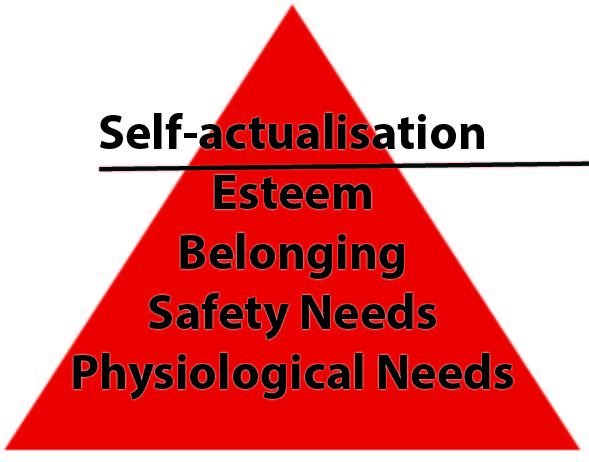Your product may be the thing that your customers buy.
But, deep down, what is it that they really want?
To avoid pain or seek pleasure?
Every decision we make is aimed at one or the other.

Pain vs Pleasure
We’re much more likely to act to avoid immediate pain, than seek immediate pleasure. If we can make something less painful or help our customers out of a jam, thats a pretty good way to go about persuading them.
If we’re motivated by fear, we want to avoid something.
If we’re motivated by pleasure, we are chasing something.
Lets break it down a bit further.
Maslow's hierarchy of needs
American psychologist Abraham Maslow outlined his theory of motivation in 1943. We can see it represented in the graphic above. The theory goes a little something like this…
In our lives, we need out basic survival and security needs met first.
We can then go about satisfying our psychological needs; forming trusting relationships with others and feeling part of a group.
Finally, after that, we can then start seeking higher level goals; prestige, accomplishment, fulfilment.
Pain and motivation levels
For the bottom 4 levels of the pyramid, motivation decreases as our needs are met.
The most motivated people are those in danger or pain right now. We need to survive and be safe right now.
Next are people who fear pain in the future.
Next are those who want pleasure in the future.
And finally those who are experiencing pleasure, and want it to continue.
Where does your customer sit...
For the first 4 levels, which are called deficit levels, motivation is stronger the lower down, and the longer your needs are unmet. EG no one likes to go hungry for a long time.
Motivation decreases once the more basic needs are met.
But fear and pain are only good motivators to get to a base level.
Lower level needs can ‘disappear’ once their satisfied.
For highest level of needs, called growth needs or being needs, they come not from a lack or deficit but a desire to grow. At the top level, motivation may actually increase once they start being met. The desire to grow further becomes stronger to more you achieve your goals.
Snakes and ladders, and straddling the pyramid
To write effectively for your customer, it helps enormously to know where they sit on this pyramid.
Expensive french wine is unlikely to appeal to our physiological requirements for survival.
Thirsty? Drink French wine!
Family cars normally highlight their safety features and spaciousness, rather than their sex appeal, high performance engines and top-end speed…
Sometimes it may be possible to appeal to multiple or all needs at once.
For example, an investment opportunity may seek to satisfy survival needs by offering financial security, esteem needs in terms of success and social recognition, and also self-actualisation via the opportunity for learning and utilising skills, and gaining financial freedom and a sense of achievement.
Many lifestyle and luxury brands can also speak to both our mid-level psychological needs to belong to social groups as well as higher level needs of esteem – gaining status and being respected – and self-actualisation goals of independence, creativity, pursuing life goals.
People can skip levels too. Even those suffering from financial hardship and struggling to meet their survival needs can spend money on luxury goods in the hope of boosting their self-esteem.
Even those who have satisfied all their deficit needs and are focused on self actualisation, retain basic fears and fear of losing it all.
Summing up...
Maslow’s hierarchy of needs is not a perfect formula for predicting our behaviour.
People can bounce around form top to bottom, bottom to top, skip levels, or try to satisfy multiple levels at once.
But it does a pretty good job of helping us know what buttons to push. Find out where your customer sits on Maslow’s hierarchy of needs and what you product does for their needs.
Once again, It all comes back to understanding your customer, their needs and what you can do for them.

